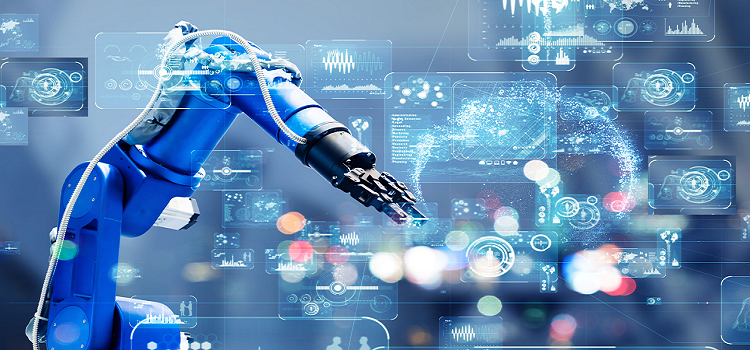How Modern Robot Software Pave the Way for Intelligent Machines
Introduction
The field of robotics has undergone a remarkable revolution, evolving from basic mechanical machines of the past to the sophisticated robots of today. Modern robots are now powered by cutting-edge software that enables them to undertake intricate tasks, make independent decisions, and even engage in interactions with humans. As technology relentlessly advances, the landscape of robot software constantly evolves, giving rise to new possibilities and ground-breaking advancements.
This blog explores the thrilling and pivotal trends in robot software shaping the future of robotics. From AI-driven learning algorithms improving robot performance to natural language processing for human-robot communication, modern robot software possesses limitless potential. Additionally, the emergence of swarm robotics, where groups of robots collaborate harmoniously to accomplish complex tasks, presents an intriguing and powerful concept expected to revolutionize various industries. Let us dive into different advancements and trends.
Artificial Intelligence Integration
The integration of Artificial Intelligence (AI) is a transformative trend in the robot software market. AI-powered robot software empowers machines with advanced capabilities, such as machine vision, natural language processing, and adaptive learning. With AI-powered robots becoming intelligent, they can perform complex tasks with precision and efficiency. This leads to a broader adoption in industries, such as manufacturing, healthcare, and logistics. The AI integration allows robots to learn from experience, reason through data, and adapt to dynamic environments, revolutionizing their capabilities and reshaping the future of robotics.
AI integration in robot software also accelerates automation, enhancing productivity and addressing the issues such as labor shortages in industries facing skill gaps. Robots can undertake tasks that were once restricted to human capabilities while improving workplace safety by handling hazardous or physically demanding operations. As the trend progresses, responsible development and ethical considerations remain vital to ensure that AI-integrated robots contribute positively to the society's progress and an overall well-being.
In November 2022, Brain Corp launched a new AI software platform for commercial robotics. This platform supports a future generation of intelligent robotic systems that can be implemented across multiple commercial sectors. The new platform, BrainOS, is designed to offer original equipment manufacturers (OEMs) a shorter time to market for high-volume automated robotics and data collection products. Brain Corp is a global leader in creating transformative core technology in robotics, and the new platform is expected to power the next generation of autonomous commercial robots.
Edge Computing for Real-time Responsiveness
Edge computing is a game-changing advancement in robotics. It enhances the capabilities and responsiveness of robot software. Unlike traditional setups that rely on centralized computing, edge computing brings data processing closer to the data source, allowing robots to process information locally. This reduces latency and enables real-time decision-making without constant internet connectivity.
The real-time responsiveness enabled by edge computing has transformative implications for various applications. For instance, in autonomous vehicles, split-second decisions are vital for avoiding obstacles and ensuring safety. With edge computing, vehicles can make critical choices onboard, improving efficiency and trust in the technology.
Industrial automation also benefits from edge computing, allowing robots to swiftly adapt to changing production conditions and optimize processes based on sensor inputs. Additionally, edge computing provides advantages in environments with limited internet access, ensuring continuous robot functionality in remote or disaster-stricken areas. Furthermore, keeping data processing local enhances privacy and security, minimizing the reliance on cloud-based services and reducing potential risks.
In November 2022, Siemens expanded its Industrial Edge platform with Operational Technology (OT) and Information Technology (IT) integration. This open and ready-to-use edge computing platform consists of edge devices, edge apps, edge connectivity, and a device management system. It enables the processing of large amounts of data in real time, which is essential for robotics applications. By bringing the computing power closer to the robots, the platform reduces latency and improves the responsiveness of robot software. This is particularly essential for applications that need real-time decision-making, such as autonomous robots.
Modular and Open-Source Robot Operating Systems
Modular and open-source robot operating systems have emerged as preferred choices in the robotics industry, due to their remarkable flexibility and collaboration. A prominent and widely adopted example is the Robot Operating System (ROS), a powerful framework that facilitates the development and seamless integration of diverse robot software components. This approach has revolutionized the robotics landscape, enabling developers to freely share code, work collaboratively on projects, and leverage existing solutions. This, in turn, propels innovation and nurtures a vibrant and supportive robotics community.
Developers can significantly expedite the creation of sophisticated robotic applications by adopting the modular and open-source operating systems such as ROS. The modular structure allows for the seamless addition or replacement of specific software components, making it easier to customize and tailor robots for specific tasks and environments. Moreover, the open-source nature of these systems increases transparency and knowledge exchange, as experts worldwide can contribute to developing and improving the software. This inclusive approach has not only resulted in a rapid evolution of robot capabilities but also cultivated a spirit of collaboration. Through this approach, researchers, hobbyists, and industry professionals can collectively work towards pushing the boundaries of robotics.
Human-Robot Collaboration and Interaction
The growing presence of robots across diverse industries has led to a significant emphasis on human-robot collaboration. This collaborative approach is made possible through the advancements in robot software, which enables robots to work harmoniously alongside humans and complement their skills and capabilities. With a focus on safety and efficiency, modern robot software empowers robots to perform tasks that enhance productivity and mitigate workplace risks. A key to this collaboration is the integration of natural language processing and gesture recognition algorithms, which facilitate smooth and intuitive communication between humans and robots. Robots can seamlessly interact with their human counterparts by understanding and responding to human commands and gestures. This, in turn, promotes a more user-friendly and efficient working environment.
Human-robot interaction has become a critical area of development in robotics, and advanced robot software plays a crucial role in this domain. By enabling robots to understand and interpret natural language commands, they can efficiently receive instructions from human operators. This streamlines the workflow and reduces the need for specialized training for robot operations, improving accessibility and inclusiveness for a wider range of users. Furthermore, gesture recognition algorithms allow robots to interpret and respond to human gestures, adding a layer of versatility and intuitiveness to their collaboration with humans. As a result, integrating these software capabilities enhances the overall human-robot interaction, fostering a cooperative and productive relationship in various industrial settings.
Cloud Connectivity for Data Sharing and Analysis
Cloud connectivity has become a crucial aspect of robot software, providing numerous benefits for seamless data sharing and analysis. Leveraging the cloud-based solutions, robots can upload their data to centralized servers and enable efficient storage and analysis of performance metrics, diagnostics, and predictive maintenance data. This centralized approach empowers organizations to gain valuable insights into their robot fleet's overall health and performance. This way, they can make data-driven decisions to optimize operational efficiency and reduce downtime.
Furthermore, cloud connectivity facilitates real-time software updates for robots, ensuring they are always equipped with the latest enhancements and security patches. This agility in software deployment enhances the adaptability and functionality of robots, enabling them to evolve alongside changing operational requirements and advancements in technology.
Enhanced Cybersecurity for Robotic Systems
Cybersecurity becomes a paramount concern as robots become integral to critical infrastructure and industrial processes. Robot software developers are focusing on implementing robust security measures to safeguard these systems against cyber threats. Techniques such as encryption, secure communication protocols, and intrusion detection systems are integrated into robot software for making sure that the confidentiality and integrity of data and operations remain intact.
Development of Swarm Robots
Swarm robotics represents a transformative approach in robotics, significantly amplifying the capabilities and expanding the applications of robot software systems. This novel paradigm revolves around the coordination and collaboration of large numbers of relatively simple robots that can together behave as a cohesive and intelligent entity. Harnessing the power of collective intelligence, swarm robotics unlocks countless possibilities and enables robots to accomplish complex tasks with remarkable efficiency and adaptability.
In addition to the practical advantages, swarm robotics has inspired innovative approaches in AI and robot software development. Algorithms that govern swarm behavior often draw inspiration from natural systems, such as social insects, birds flocking, or fish schooling. These bio-inspired algorithms pave the way for novel techniques in optimization, task allocation, and decision-making by fostering interdisciplinary research and pushing the boundaries of robot software capabilities.
Conclusion
The future of robotics is undoubtedly exciting, with software advancements playing a pivotal role in shaping intelligent machines. AI integration, edge computing, modular and open-source operating systems, reinforcement learning, human-robot collaboration, cloud connectivity, and enhanced cybersecurity are just a few of the trends driving the evolution of robot software. As these trends continue to unfold, robots are expected to become more autonomous and efficient, which will transform industries and the daily lives of humans in profound ways. However, alongside these developments, it is crucial to address ethical considerations and ensure responsible deployment to fully harness the potential of robotics for the betterment of society.
About the Author
 Shankar Nishant is a researcher at Next Move Strategy Consulting with a cumulative experience of more than four years. Shankar is enthusiastic about new technology, enjoys working with diverse global clients, and has delivered numerous market reports in multiple domains. He can be reached at shankar.dutta@nextmsc.com
Shankar Nishant is a researcher at Next Move Strategy Consulting with a cumulative experience of more than four years. Shankar is enthusiastic about new technology, enjoys working with diverse global clients, and has delivered numerous market reports in multiple domains. He can be reached at shankar.dutta@nextmsc.com


Leave a Reply